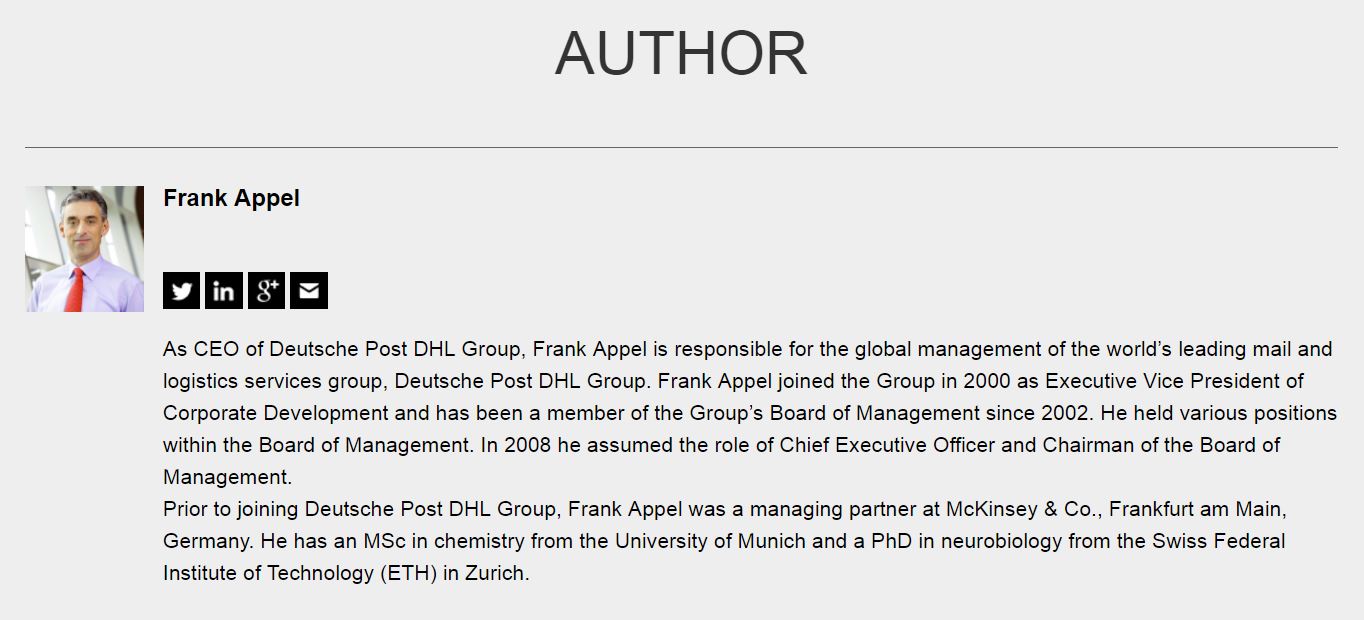SDG #17 Deutsche Post DHL and Ford partners to build 2500 electric vans by 2018, with production start July 2017.
For the international community, environmental protection and climate-efficient transportation have long since become “must haves” – an obligation that all of us share today and into the future. The UN Paris Climate Accord established the goal of limiting global warming to less than two degrees Celsius above pre-industrial levels. We will only reach this goal if we can accelerate our progress in the area of climate-efficiency.
As the world’s market leader in logistics and a pioneer in green logistics, Deutsche Post DHL Group is positioned to make a significant contribution to this effort. By 2050 we want to reduce all logistics-related emissions to net zero. Throughout the company’s history, we’ve often played the role of a trailblazer, and this is exactly what we will continue to do.
In 2016, with the help of our Group-wide environmental protection program GoGreen, we achieved a 30% improvement in carbon efficiency as compared to the 2007 baseline. We originally set this target for the year 2020, which means we achieved our goal four years ahead of schedule. We pulled a number of levers to make this achievement possible. We worked with our customers to implement optimization measures throughout the supply chain, and today our logistics network is significantly more climate-efficient as a result. The environmental and energy management systems put in place in our production facilities include everything from the latest lighting technologies to electricity generated from renewable energies.
Last year alone we invested several million euros in modernizing our aircraft. The updated aircraft, which feature larger load capacity and updated technologies, are significantly more environmentally friendly than previous models and require fewer repairs.
E-mobility, however, is one of the most critical levers for achieving greater climate efficiency in logistics. To be sure, there are still a number of hurdles to overcome before e-mobility establishes itself on a large scale and achieves the status it deserves as an indispensable component of climate-efficient infrastructures. This applies in particular to urban transport. Uniform standards for measuring emissions are needed, and more must be invested in vehicle efficiency technologies. But these challenges should by no means prevent us from transitioning to e-mobility today wherever possible.
The StreetScooter, the Group’s own electric vehicle for delivering mail and parcels, is another example of Deutsche Post DHL Group consciously taking the lead on climate. What prompted us to do this? It’s simple: an electric vehicle that met our requirements didn’t yet exist on the market. So we seized the initiative and built it ourselves.
Today there are already over 2,500 StreetScooters on the road in Germany, with at least twice as many projected by the end of 2017. In neighboring European countries the StreetScooter, a disruptor of sorts in the auto industry, is also being tested successfully. Over the long term, we will transition our entire fleet to electric vehicles. Moreover, we are already offering the StreetScooter for sale to third parties. We want to be a driver of green logistics; e-mobility is crucial because it means growth no longer translates automatically into a larger environmental burden.
Today, digitalization is transforming nearly all areas of life and work and I am sure that new technologies will continue to open up roads to more climate-efficient and climate-neutral logistics. This is one reason to be optimistic about achieving our goal of “zero emission logistics” by 2050. Nevertheless, we’re taking a systematic and resolute approach to making sure we realize our long-term vision. We will measure our progress in stages and have set detailed interim goals to be achieved by 2025:
- At the global level, we will improve the carbon efficiency of our own activities and those of our transport subcontractors by 50% as compared to the 2007 baseline. I firmly believe that we can achieve this goal.
- At the local level, we want to deploy clean transportation solutions to improve the quality of life in places where people live and work. To this end, we will transition 70% of our own first and last mile services to clean pick-up and delivery solutions. Our electric StreetScooter is just the right vehicle for the job, and we will continue to systematically expand our zero-emissions delivery operations. Just a few days ago, StreetScooter GmbH entered into a partnership with Ford Werke GmbH. Together we will become Europe’s largest manufacturer of medium-duty electric-powered delivery vehicles. Production is set to begin in July and, by the end of 2018, we will deploy at least 2,500 StreetScooter vehicles for our company’s urban delivery operations.
- Increasingly, our customers are setting their own climate-efficiency targets and we will make every effort to support them in achieving these targets with the help of carbon reports, climate-neutral solutions, as well as with innovative circular economy solutions. By 2025 we want more than 50% of our sales to incorporate green solutions for greener customer supply chains.
- In a service industry such as logistics, employees make all the difference. By 2025 we will train 80% of our employees worldwide to become certified green logistics experts and actively involve them in our environmental and climate protection activities. Already today many of our people throughout the world are very involved in our annual Global Volunteer Day. Climate protection has long since been part of this initiative and we plan to expand its role in the future. Our employees, for example, will join partners in planting one million trees every year.
There are so many things we can do on behalf of the climate and health of our planet; we just need to commit to the challenge. As providers and customers of logistics services, we decide each and every day on the future of our planet. With its Sustainability Goal #17 (“Partnerships for the Goals”) the United Nations also emphasizes this idea of joint responsibility. The key will be implementing the 2030 Agenda at all levels and all actionable areas of our lives in a way that is measurable.
Our decisions today determine the world in which we and our children will live 30 years from now. To ensure a healthy planet tomorrow, we must act decisively today. Putting climate protection at the top of the agenda is the only way to maintain the health of our planet, and that is exactly what our children and grandchildren expect us to do.





2 Comments
Pingback: bet9ja on Devs.ng
Pingback: ยาเพิ่มขนาด